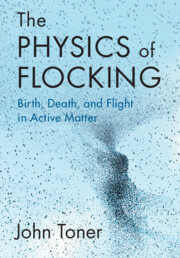401 results
4 - Formulating the Hydrodynamic Model for Flocking
-
- Book:
- The Physics of Flocking
- Published online:
- 16 May 2024
- Print publication:
- 23 May 2024, pp 88-116
-
- Chapter
- Export citation
2 - Dynamical Derivation (and a More Conventional One) of the Mermin–Wagner–Hohenberg Theorem; or, Why We Can’t All Point the Same Way
-
- Book:
- The Physics of Flocking
- Published online:
- 16 May 2024
- Print publication:
- 23 May 2024, pp 9-29
-
- Chapter
- Export citation
6 - Incompressible Polar Active Fluids in the Moving Phase in Dimensions d > 2: the “Canonical” Exponents
-
- Book:
- The Physics of Flocking
- Published online:
- 16 May 2024
- Print publication:
- 23 May 2024, pp 121-134
-
- Chapter
- Export citation
3 - The Dynamical Renormalization Group; or, WhyWe Can Do Physics, Illustrated by the KPZ Equation
-
- Book:
- The Physics of Flocking
- Published online:
- 16 May 2024
- Print publication:
- 23 May 2024, pp 30-87
-
- Chapter
- Export citation
8 - Incompressible Flocks in Spatial Dimensions d = 2: Mapping to the KPZ Equation
-
- Book:
- The Physics of Flocking
- Published online:
- 16 May 2024
- Print publication:
- 23 May 2024, pp 140-163
-
- Chapter
- Export citation
5 - The Dynamical Renormalization Group Applied to the Flocking Problem
-
- Book:
- The Physics of Flocking
- Published online:
- 16 May 2024
- Print publication:
- 23 May 2024, pp 117-120
-
- Chapter
- Export citation

The Physics of Flocking
- Birth, Death, and Flight in Active Matter
-
- Published online:
- 16 May 2024
- Print publication:
- 23 May 2024
Are Odd Radio Circles phoenixes of powerful radio galaxies?
-
- Journal:
- Publications of the Astronomical Society of Australia / Volume 41 / 2024
- Published online by Cambridge University Press:
- 05 March 2024, e024
-
- Article
-
- You have access
- Open access
- HTML
- Export citation
Hydrodynamic and kinetic representation of the microscopic classic dynamics at the transition on the macroscopic scale
-
- Journal:
- Journal of Plasma Physics / Volume 90 / Issue 1 / June 2024
- Published online by Cambridge University Press:
- 02 February 2024, 905900108
-
- Article
- Export citation
Hybrid axisymmetric model for forced heave of a shallowly submerged cylindrical wave energy converter
-
- Journal:
- Flow: Applications of Fluid Mechanics / Volume 3 / 2023
- Published online by Cambridge University Press:
- 08 November 2023, E36
-
- Article
-
- You have access
- Open access
- HTML
- Export citation
Hydroinformatics: A review and future outlook
-
- Journal:
- Cambridge Prisms: Water / Volume 1 / 2023
- Published online by Cambridge University Press:
- 26 September 2023, e10
-
- Article
-
- You have access
- Open access
- HTML
- Export citation
CosmoDRAGoN simulations—I. Dynamics and observable signatures of radio jets in cosmological environments
-
- Journal:
- Publications of the Astronomical Society of Australia / Volume 40 / 2023
- Published online by Cambridge University Press:
- 12 April 2023, e014
-
- Article
-
- You have access
- Open access
- HTML
- Export citation
2 - The Material Derivative: The First Step to the Navier–Stokes Equations
-
- Book:
- A Student's Guide to the Navier-Stokes Equations
- Published online:
- 10 March 2023
- Print publication:
- 09 February 2023, pp 32-59
-
- Chapter
- Export citation
4 - The Navier–Stokes Equations: Another Approach
-
- Book:
- A Student's Guide to the Navier-Stokes Equations
- Published online:
- 10 March 2023
- Print publication:
- 09 February 2023, pp 102-123
-
- Chapter
- Export citation
3 - Force Balance, the Stress Tensor, and the Navier–Stokes Equations
-
- Book:
- A Student's Guide to the Navier-Stokes Equations
- Published online:
- 10 March 2023
- Print publication:
- 09 February 2023, pp 60-101
-
- Chapter
- Export citation
1 - Mass Conservation and the Continuity Equation
-
- Book:
- A Student's Guide to the Navier-Stokes Equations
- Published online:
- 10 March 2023
- Print publication:
- 09 February 2023, pp 1-31
-
- Chapter
- Export citation
6 - Nondimensionalization and Scaling
-
- Book:
- A Student's Guide to the Navier-Stokes Equations
- Published online:
- 10 March 2023
- Print publication:
- 09 February 2023, pp 182-219
-
- Chapter
- Export citation
5 - The Energy Equation and a Discussion on Diffusion and Advection
-
- Book:
- A Student's Guide to the Navier-Stokes Equations
- Published online:
- 10 March 2023
- Print publication:
- 09 February 2023, pp 124-181
-
- Chapter
- Export citation
7 - Hydrodynamic Theory
-
- Book:
- Handbook of Hydraulic Geometry
- Published online:
- 24 November 2022
- Print publication:
- 08 December 2022, pp 210-244
-
- Chapter
- Export citation
A 4000 Mʘ supermassive star as a possible source for the W1 kilomaser
-
- Journal:
- Proceedings of the International Astronomical Union / Volume 18 / Issue S380 / December 2022
- Published online by Cambridge University Press:
- 07 February 2024, pp. 36-39
- Print publication:
- December 2022
-
- Article
- Export citation



